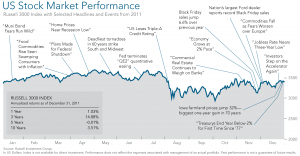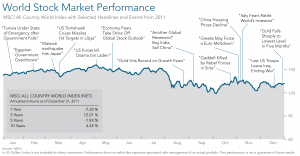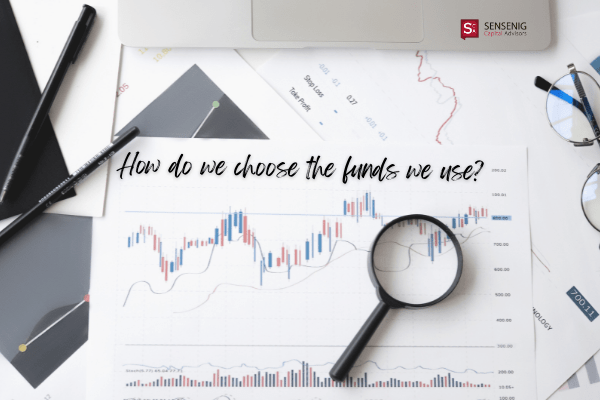The past year reminded investors that they should hope for the best, prepare for the worst, and be thankful when reality does not match their fears. Investors entered 2011 with hopes that the world economy would continue recovering from a long and painful deleveraging process. Equity markets had posted two straight years of positive performance, central banks remained committed to pro-growth monetary policy, and major developed nations were focused on reducing debt.
By mid-year, however, optimism faded as troubling events around the world dominated headlines. The devastating earthquake and tsunami in Japan, political unrest in the Middle East, rising oil prices, a US credit downgrade, the threat of another global recession, and an escalating debt crisis in Europe weighed heavily on markets. As stock market volatility returned to global financial crisis levels, investors faced a major test to their discipline and staying power.
Although US stocks experienced some of the highest volatility in years, the broad US market delivered flat performance in 2011. Developed markets logged negative returns, and emerging markets had mixed performance, with most countries also underperforming the US. The bright spots were in the fixed income arena, where a flight to quality triggered by the euro debt crisis and US credit downgrade boosted returns on US government securities, inflation-protected securities, and municipal bonds.
The above headliner graph features some of the year’s most highly publicized events in the context of the Russell 3000 Index, a broad indicator of US stock market performance. These events are not offered as an explanation of market performance, but as an illustration that a volatile news environment can challenge even the most disciplined long-term investors.
The World Stock Market Performance chart below offers a snapshot of global stock market performance, as measured by the MSCI All Country World Index. Actual headlines from publications around the world are featured. Again, these headlines are just a sample of events during the year.
Throughout the year, investors could find a host of reasons to avoid stocks and wait for more positive news before returning to the market. As these select headlines suggest, determining the right time to invest is a difficult task since the market anticipates news and quickly factors in new information.
The Year in Review
In 2011, global diversification proved as important as ever. Although diversification may not have prevented losses, investors with broadly diversified portfolios were better equipped to endure the uncertainty. Major themes during the year included:
European Debt Problems
The sovereign debt crisis intensified as European authorities struggled to avert a Greek debt default and alleviate fiscal pressures in Italy and France. But these restructuring attempts fell short of market expectations, which spooked investors and raised concerns of additional sovereign debt downgrades and a possible breakup of the Eurozone. The crisis also hurt European banks holding large positions in sovereign debt. To avoid losses, leading institutions reduced lending and dumped assets, which depressed asset values. Higher borrowing costs in the most indebted countries, combined with reduced government spending and revenues, raised more concerns that the Eurozone was entering a recession in late 2011.
Economic Uncertainty
Since the global financial crisis in 2008, central banks and governments have taken bold measures to fuel business activity and stabilize financial markets—and investors have eagerly awaited signs that economic recovery has taken hold. The economic signals continued to be mixed in 2011. Favorable US news included strong corporate profits and dividends, substantial levels of cash on corporate balance sheets, low interest rates and inflation, a booming domestic energy sector, continuing strength in auto sales, record-high share prices for some multinationals, and improved fourth-quarter numbers in manufacturing, exports, consumer confidence, and employment. Pessimists could point to the longstanding jobless trend, slumping home prices, tepid growth in retail sales, worrisome levels of government debt, and political gridlock at both the national and state levels.
Although emerging economies showed resilience, investors were concerned that another recession in Europe would impact its trading partners in emerging economies—and particularly in China, where high inflation and a manufacturing slowdown threatened to send its previously fast-growing economy into recession.
Rising Volatility
Investors in US equities had to endure a heavy dose of uncertainty for their moderate gains. The S&P 500 Index reflected this volatility by closing up or down over 2% on thirty-five days in 2011, compared to twenty-two days in 2010. By contrast, before the global financial crisis, the index did not have a single day with a 2% or more movement in 2005, and only two days in 2006.
Market observers also documented higher correlations among individual stocks and between asset classes. In 2011, there were sixty-nine days in which 90% of the S&P 500 stocks moved in the same direction, which is more than the combined total for 2008 and 2009. Higher correlations are common during periods of uncertainty, as macroeconomic forces overshadow the impact of a company’s business fundamentals on its stock price.
Falling Commodity Prices
In early 2011, commodities soared with expectations of improving economic growth around the world. Copper, cotton, and corn hit all-time highs in the first half of the year. Crude oil experienced double-digit returns in response to anticipated higher demand and threats of supply disruptions tied to political unrest in the Middle East. The Dow Jones-UBS Commodity Index peaked in April, then fell 20% as the global economic outlook faded. The index returned -13% for the year—its first negative return since 2008. The most notable exception was gold, which set more records in 2011 and peaked at $1,888.70 per ounce in August before declining in the fourth quarter to return about 10% for the year.
Investor Risk Aversion
The fragile world economy made markets particularly vulnerable to shifting investor sentiment. During the year, investors reacted to uncertainty by moving to asset classes they deemed more stable, including large cap stocks and government bonds. Despite the Standard & Poor’s downgrade of the US credit rating in early August, investors fled to US government securities as concerns mounted over the sovereign debt crisis in Europe and political stalemate over the US debt ceiling.
2011 Investment Overview
Most global equity investors experienced negative returns in 2011. After a strong first-quarter start, developed equity markets grew more volatile in response to discouraging news on the economy and sovereign debt crisis. Despite a brief rebound in July and during the fourth quarter, most equity markets logged negative performance for the year.
The US stock market was one of the few developed markets to experience positive returns. The S&P 500 logged a 2.11% gain (dividends reinvested), and the Russell 3000 returned 1.03% for the year. Despite strong returns in the fourth quarter, developed and emerging markets logged negative returns, with thirty-seven of the forty-five countries that MSCI tracks posting losses. The MSCI World ex USA Index returned 12.2% and the MSCI Emerging Markets Index returned 18.4% for the year. Ireland and New Zealand were the only developed markets besides the US to end the year in positive territory. Indonesia was the only emerging market that ended the year with positive returns, and Egypt was by far the worst performer.
The US dollar fluctuated but finished about 3% above where it started against most developed-market currencies. It sharply appreciated against the main emerging market currencies, especially against the Indian rupee and the Brazilian real. This relative strength negatively impacted dollar-denominated returns of emerging market equities. The euro remained stable during the year even as analysts began predicting the dissolution of the currency zone, and the Japanese yen and the Australian dollar both gained against the US dollar.
Along the size dimension, large caps outperformed small caps in the US, non-US developed, and emerging markets. Value stocks underperformed growth stocks in the US, but mostly outperformed growth among emerging markets and had mixed results in developed markets.
In the fixed income arena, US intermediate-term government securities and TIPS performed exceptionally well, returning over 9.4% and 14.5%, respectively. Real estate securities in the US had strong positive returns and excellent performance relative to other US asset classes; in other developed markets, REITs had sharply negative returns but still managed to have good performance relative to other asset classes.
Quarterly Highlights
First Quarter
Despite natural disasters in Japan and other countries, increased political turmoil in the Middle East and North Africa, and rising commodities prices, world equity markets logged positive performance. Strong returns in January and February gave the US equity market its best first quarter since 1998. The broad US market gained over 6%, with all asset classes delivering positive returns. Investors were encouraged by improving economic data, especially in the labor market.
Overall performance in other developed markets was above average, although not as strong as in the US. Markets experienced divergent performance at the individual country level. Japan, which suffered a devastating earthquake and subsequent tsunami and nuclear crisis, had sharply negative returns for the quarter. Some of the worst performers in 2010—including Spain and Italy—were the top performers in the quarter. The US dollar lost ground against most major currencies except the yen, which helped the dollar-denominated returns of developed market equities.
Emerging markets had subpar but positive returns and trailed developed markets in the quarter. As in developed markets, there was much dispersion in the performance of emerging markets. Russia and other Eastern European countries performed exceptionally well in the quarter. The US dollar also lost ground against the main emerging market currencies in the first quarter, which contributed positively to the dollar-denominated returns of emerging market equities. Most fixed income securities had flat or slightly negative returns in the quarter. Inflation-protected securities, which had very strong returns, were the main exception. Real estate securities had strong returns in the first quarter and good performance relative to other asset classes.
Second Quarter
Despite weaker-than-expected economic data in the US, and Europe’s sovereign debt crisis, equity markets around the world were little changed in the second quarter. The broad US market was flat, and in US dollar terms, overall performance in other developed markets was slightly positive. As in most of the past few quarters, there was much dispersion in performance at the individual country level. Greece, which once again had to be bailed out by the European Union and the International Monetary Fund to avoid defaulting on its sovereign debt, had sharply negative returns for the quarter. New Zealand and core European countries such as Germany and France had strong positive returns.
The US dollar lost ground against all major currencies, which helped the dollar-denominated returns of developed market equities. Emerging markets had negative returns and trailed developed markets in the quarter. Indonesia and other small emerging markets in Asia did well. On the other hand, some of the largest emerging countries such as China, Brazil, India, and Russia had sharply negative returns and were among the worst performers. The US dollar also lost ground against the main emerging market currencies, which contributed positively to the dollar-denominated returns of emerging market equities. Most fixed income securities had excellent returns, especially inflation-protected securities. Real estate securities had strong returns and excellent performance relative to other asset classes.
Third Quarter
Equity markets around the world had their worst quarter since the end of 2008, as investors reacted negatively to the continuing sovereign debt problems in Europe, the budget stalemate in the US, and poor economic data in most developed countries and in some large emerging countries such as China. The broad US market lost over 15%.
In US dollar terms, overall performance in other developed markets was even worse, but that performance differential with the US was entirely due to currency fluctuations. Greece, which remained at the center of Europe’s sovereign debt problems, was by far the worst performer. At the other end of the spectrum, Japan, whose dollar-denominated returns greatly benefited from the strength of the yen, and New Zealand were the top performers. The US dollar gained against most major currencies except the yen, which hurt the dollar-denominated returns of developed market equities.
Emerging markets as a whole had similar performance to developed markets, but a strengthening dollar relative to the main emerging market currencies resulted in sharply negative dollar-denominated returns in most emerging markets. Peru and some of the smaller emerging markets in Asia did relatively well, while Russia and other European markets were among the worst performers.
Most fixed income securities had excellent returns. Despite Standard & Poor’s decision in early August to downgrade the credit rating of the US, investors rushed to the safety of US Treasury securities in light of weak economic data in the US and abroad, and especially among concerns about Europe’s ability to resolve its sovereign debt problems. Real estate securities had poor returns but good performance relative to other equity asset classes.
Fourth Quarter
Led by the excellent performance of US stocks, global equity markets posted strong returns in the quarter. Those returns, however, were not sufficient to overcome a dismal third quarter, and most markets had negative returns for the year. The quarter was also characterized by a sharp increase in volatility.
The broad US market gained over 12% in the quarter. In US dollar terms, the quarterly returns for developed non-US markets were over 3%—above the historical average but far behind the US. Greece, which remained at the center of Europe’s sovereign debt woes, was by far the worst performer in both the quarter and the year, while Ireland, the Scandinavian countries, and Australia were the top performers for the quarter.
The US dollar appreciated against major European currencies, which slightly hurt the dollar-denominated returns of developed market equities, and had mixed performance against the main emerging market currencies. In US dollar terms, emerging markets gained about 4% in the quarter, in line with the historical average, but not enough to overcome their poor performance of the third quarter. Malaysia and other smaller emerging markets such as Thailand and Peru posted double-digit returns. Turkey and Egypt had double-digit negative returns in the quarter.
Yields on Treasury securities across the whole maturity spectrum were little changed during the fourth quarter. With regard to credit risk, spreads between more- and less-risky fixed income securities generally became wider during the quarter. Real estate securities had positive returns in the fourth quarter but mixed performance relative to other asset classes. In the US, they were among the top performers, while in other developed markets, they trailed most other asset classes.
Russell data copyright © Russell Investment Group 1995-2012, all rights reserved. Dow Jones data provided by Dow Jones Indexes. MSCI data copyright MSCI 2012, all rights reserved. S&P data provided by Standard & Poor’s Index Services Group. The Merrill Lynch Indices are used with permission; copyright 2012 Merrill Lynch, Pierce, Fenner & Smith Incorporated; all rights reserved. Citigroup bond indices copyright 2012 by Citigroup. Barclays Capital data provided by Barclays Bank PLC. Indices are not available for direct investment; their performance does not reflect the expenses associated with the management of an actual portfolio. Past performance is no guarantee of future results. This information is provided for educational purposes only and should not be considered investment advice or a solicitation to buy or sell securities. Dimensional Fund Advisors LP is an investment advisor registered with the Securities and Exchange Commission.







